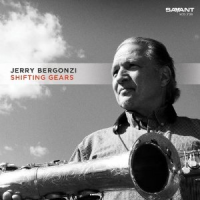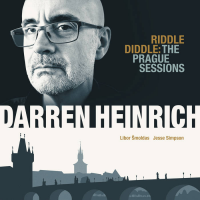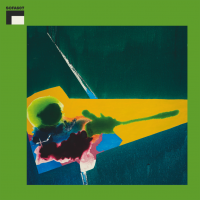Home » Jazz Articles » Multiple Reviews » Los Lobos: Kiko @ 20 (x3)
Los Lobos: Kiko @ 20 (x3)

The comparison to an iconic—but, with the exception of Robertson, equally unassuming—quintet that, after backing Bob Dylan, entered the world as a distinct entity with the groundbreaking Music from Big Pink (Capitol, 1968), may seem hyperbolic...or even a tad sycophantic. But with the release of the remastered and expanded Kiko: 20th Anniversary Edition, along with a 2006 live performance of the album in its entirety in CD, DVD and Blu-Ray formats, it's an opportunity to evaluate its significance and ultimate touchstone for groups like Wilco, Ozomatli and The Blazers.
Los Lobos had already gained significant visibility and commercial success with its breakthrough second recording, How Will the Wolf Survive? (Slash, 1984), a full six years after Del Este De Los Angeles (Hollywood, 1978) introduced the group and, on that record, its particularly dominant Mexican roots. But even its 1978 debut came another six years after the group formed while still in high school—initially a wedding and party band that played the traditional Mexican music of its youth (often acoustic), but gradually accepting the irresistible influence of rock music, coming from the diverse tastes of founding members and primary writers David Hidalgo (guitar, accordion, vocals) and Louis Pérez (drums, guitar, vocals) that ranged from The Byrds and Fairport Convention to Randy Newman and Ry Cooder.
Despite "Will the Wolf Survive" entering the US charts in 1984 and, three year later, scoring a massive #1 hit with the title song to director Luis Valdez's 1987 Ritchie Valens biopic, La Bamba, Los Lobos refused to pander to commercial demands, with By the Light of the Moon (Slash, 1987) and La Pistola y el Corazón (Slash, 1988) remaining schizophrenically divided between traditional concerns and more rock-inflected songs written by Hidalgo, Pérez and Cesar Rosas (guitar vocals). But with 1990's The Neighborhood (Slash), Los Lobos began to both assimilate its various musical predilections into a more cohesive sound, while still remaining true to its own wants, needs and desires.
At this point, Los Lobos was, however, pretty much a meat-and-potatoes band, albeit a hot one, whose live shows allowed the group—Hidalgo and Rosas, in particular—to stretch out more from the confines of its shorter studio tracks.
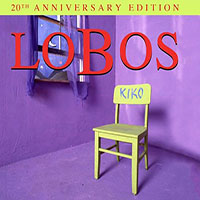 Los Lobos
Los LobosKiko: 20th Anniversary Edition
Shout! Factory
2012 (1992)
Still, sometimes serendipity happens when least expected. Hidalgo and Perez's habit of meeting at the back of a bookstore everyday to begin writing the music that would ultimately appear on Kiko already signified a shift, as the two began exploring classical Japanese poetry and applying its concepts to their own writing. But if studio demo versions of the hard-rocking "Whiskey Trail" and mariachi-tinged, roots-centric "Rio de Tenampa"—both included in this expanded Kiko: 20th Anniversary Edition—suggested growing confidence and more complete conception, one listen to the versions ultimately released are enough to clarify the significant impact producer Mitchell Froom and engineer Tchad Blake had on the end result.
In the interview footage associated with the Kiko Live DVD, the band marvels at the freedom provided in working with Froom and Blake, who'd already scored a big hit with Crowded House's eponymous Capitol debut in addition to bringing a personal touch to albums by singer/songwriters Richard Thompson, Pat McLaughlin...even ex-The Beatles' Paul McCartney. The two had also worked with Los Lobos on The Neighborhood, but it's with Kiko that Froom, Blake and Los Lobos reached that rarefied level of creativity to which all aspire but few actually achieve. One listen to the brass band intro to the album-closing "Rio de Tenampa"—drums gated and compressed, horns fed through effects to create an ethereal, out-of-time vibe—and it's clear that Los Lobos had reached a new plateau, one where the more abstract and, at times, oblique nature of its lyrics were matched by the band's performances and the sounds achieved in the studio.
While they were an essential component, the success of Kiko is hardly due solely to Froom and Blake's influence. Bassist Conrad R. Lozano's simple grooves may not be as tuba-esque as Rick Danko's fretless playing with The Band, but they're just as unshakable...and note-perfect. Saxophonist/keyboardist Steve Berlin has always been about texture and feeding the ensemble rather than virtuosity and self-promotion, but his overdubbed parts are both ominously massive and the perfect intimation of the "something going wrong" at the core of "Reva's House." And if Hidalgo and Rosas are not exactly virtuosic in the manner of, say, Richard Thompson, they're nevertheless remarkably astute players who interact and interlock rhythmically with a kind of loose facility that—heard to perfection on the opening "Dream in Blue" and later "That Train Don't Stop" and, again, referencing The Band's similar sound—is never played the same way twice. Perez's contributions are, perhaps, more dominant on the songwriting front, but when he takes a rare lead vocal spot from Rosas and Hidalgo on the all-acoustic "Saint Behind the Glass"—a deceptively simple yet revealing song, seen from the perspective of a young child looking around his one-room house—his unassuming delivery elevates the song to similar greatness, especially when blended with the thumping sound of Lozano's massive guitarrón, and Fermin Herrera's delicate Veracruz harp.
While Pérez was Los Lobos' original drummer (and still plays some kit on record), by the time of The Neighborhood, the group had begun recruiting veteran session drummers like Jerry Marotta and Jim Keltner, while longtime Elvis Costello Attractions band mate Pete Thomas drives the groove throughout most of Kiko. It was only with 2002's Good Morning Aztlán (Mammoth) that Los Lobos found a permanent drummer in Cougar Estrada. Still, while Pérez's instrumental contributions are less in-the-spotlight, his irreplaceable role as imaginary lyrical visionary keep remains an essential part of Los Lobos' universe. All but three of Kiko's 16 original tracks are co-written by Pérez and Hidalgo, with Rosas contributing "Whiskey Trail," the grungy, post-psychedelic "Wicked Rain," and effortlessly swinging "That Train Don't Stop Here," his post-Jimi Hendrixian solos contrasting Hidalgo's more unprocessed, blues-tinged lines.
Froom and Blake's acumen on songs like the title track are what distinguish Kiko. Lyrically surreal, the tune blends mellotron saxophone samples with Hidalgo's accordion for a perfect confluence of Mexican tradition, jazz and roots music that is why, in the final analysis, Kiko bears comparison to The Band—an album that similarly marries extreme multi-instrumentalism, cultural cross-pollination and, yes, rock 'n' roll.
Los Lobos has continued to make strong records, but never another like Kiko, and if there's one thing this 25th Anniversary Edition suggests, it's that one is surely enough. Attempts to recreate Kiko's particular space would have failed in contrast, if for no other reason than being an intended attempt at finding the same serendipity. Instead, Los Lobos has continued to pursue its muse, ultimately returning to a more direct sound on Tin Can Trust but with plenty of lessons learned in the interim. A classic from start to finish—the result of hi-fi/low-fi experimentation, a paradigm shift in songwriting approach, and the ultimate coalescence of the various influences that drove the genesis of Los Lobos—Kiko is an essential recording that also demonstrates the much-maligned 1990s still had at least some things going for it.
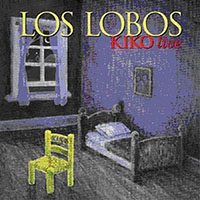 Los Lobos
Los LobosKiko Live (CD)
Shout! Factory
2012
It's no surprise that Los Lobos never performed Kiko in its entirety; few bands do. After all, with nearly half a dozen albums behind it and at least a couple hit songs, the band chose to do what most do: play a mix of material from all its albums, with selected songs from its latest interspersed. But with the critical acclaim and reputation that Kiko continued to garner over the years, the group decided to launch a short tour in December, 2005, to perform the music of Kiko in sequence, start to finish. Illness of one of its members postponed the planned January 6, 2006 finale at San Diego's House of Blues to February 24, so another date was added the night before in Ventura, most likely as a warm-up, since the HoB show was to be recorded for both audio and video.
That it's taken over six years for Kiko Live to see the light of day, is not exactly serendipity (it was, after all, ultimately planned), but it is another example of confluence, with the release of Kiko: 20th Anniversary Edition lending both sets a greater raison d'être. Live, with the core group plus drummer Cougar Estrada and a handful of guests—harpist Angel Abundez to help with "Saint Behind the Glass," Hidalgo's son, drummer David Jr., propelling an especially hard-rocking "Whiskey Trail," and a six-piece band recruited for the closing " Rio de Tenampa"—Los Lobos tears through the album top-to-bottom, and what it lacks in the studio album's larger production values it more than makes up for in sheer energy and a chance to stretch a few of the tracks, in particular the visceral "Dream in Blue" and grinding "Just a Man," featuring plenty of guitar workouts from Hidalgo, Rosas and, at the end of the brighter "Peace," a rare solo spot for Pérez.
It's largely back to meat and potatoes since, unlike so many bands which would bring samplers and added members to more accurately reproduce the album's rich sonics, Los Lobos chose, instead, for a simple presentation: the band, a few essential guests and plenty of guitars. Berlin's got the horn samples that are essential to the title track's vibe, but even though it would be possible to gate the drums and horns of "Rio de Tenampa" at the soundboard, that just isn't the way Los Lobos approaches performance. Instead, it's a relatively low-fi approach—with some foot pedals to be sure, but largely of a vintage variety—giving Rosas and Hidalgo the freedom to turn in some searing guitar work on a version of "Wicked Rain" that may be at almost the exact tempo, click-for-click, of the original, but gets elevated here to its own classic status through a frenzied ending that's even more effective than the studio version's admittedly appropriate fade-out.
All in all, it's the kind of performance Los Lobos is known for, and can be heard on Live at the Fillmore (Hollywood, 2005)—where the group coincidentally performs "Kiko" and "Saint Behind the Glass"—with the group substituting energy and commitment for finesse...and the kind of onstage comfort that comes from five of its six members playing together for nearly forty years.
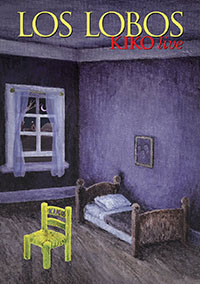 Los Lobos
Los LobosKiko Live (DVD)
Shout! Factory
2012
The DVD version of the same concert includes 25 minutes of interview footage that, while interspersed throughout the performance, can also be omitted as well—something other concert videos would be well-advised to do, since such material may be informative and worth watching once, maybe even twice, but ultimately becomes a distraction. Here, with Lozano driving his car, with the visible license plate, "HEALERS," it becomes clear that success hasn't spoiled Los Lobos; instead, it really is just a bunch of, well, guys who play in a band the way others conduct their lives: no muss, no fuss, no excessive navel-gazing. Perez is, perhaps, the most articulate—no surprise, since he's largely a wordsmith—but interview segments with everyone reveal a composite view. Froom and Blake are also interviewed, and if Los Lobos' respect, admiration and appreciation for the help the producer and engineer provided in the creation of Kiko, the feelings are clearly mutual.
One of the most enlightening pieces of interview footage is not a part of the regular program but is, instead, one of three bonus "vignettes." Called "Hi-Fi/Low-Fi," it features Blake explaining how a newly minted guitar pedal ended up being fundamental to Kiko, albeit used on everything but the guitars, instead overdriving the horns and drums to give songs like "Rio de Tanampa" its surreal vibe.
With the live CD running very close to 80 minutes, the DVD also includes a nearly 14-minute encore impossible to include, that brings Los Lobos back to its roots as an acoustic band, performing "Carabina 30-30," "Volver, Volver" and a version of "La Bamba" that's closer to its original roots as a Mexican wedding song than the group's rocking hit version.
With three separate ways to celebrate the 20th anniversary of Kiko (four, if you include the video release on DVD and Blu-Ray, though the two versions are identical), and a chance to finally hear the record performed live in its entirety, the entire bundle provides a compelling picture of a band that, 40 years later and with plenty of critical and popular acclaim, truly remains "Just Another Band from East L.A."
Tracks and Personnel
Kiko: 20th Anniversary Edition
Tracks: Dream in Blue; Wake Up Dolores; Angels with Dirty Faces; That Train Don't Stop Here; Kiko and the Lavender Moon; Saint Behind the Glass; Reva's House; When the Circus Comes; Arizona Skies; Short Side of Nothing; Two Janes; Wicked Rain; Whiskey Trail; Just a Man; Peace; Rio de Tenampa; Whiskey Trail (studio demo); Rio de Tenampa (studio demo); Peace (live); Arizona Skies/Borinquen Patria Mia (live); Kiko and the Lavendar Moon (live).
Personnel: Steve Berlin: tenor, baritone and soprano saxophone, flute, melodic, harmonica, organ, piano, synthesizer, percussion; David Hidalgo: guitars, accordion, violin, banjo, piano, percussion, vocals; Conrad R. Lozano: Fender 5-string Jazz bass and 4-string Precision bass, Godin fretless bass, guitarrón, background vocals; Louie Perez: drums, vocals, guitars, percussion, couch and phone; Cesar Rosas: electric and acoustic guitars, vocals; Pete Thomas: drums; Victor Bisetti: drums (15, 16), percussion; Fermin Herrera: Veracruz harp (6); Alex Acuña: percussion; Gary Mallaber: drums (2); Mitchell Froom and his House of Keyboards La Chilapeña brass band.
Kiko Live (CD)
Tracks: Dream in Blue; Wake Up Dolores; Angels with Dirty Faces; That Train Don't Stop Here; Kiko and the Lavender Moon; Saint Behind the Glass; Reva's House; When the Circus Comes; Arizona Skies; Short Side of Nothing; Two Janes; Wicked Rain; Whiskey Trail; Just a Man; Peace; Rio de Tenampa.
Personnel: David Hidalgo: guitar, vocals, accordion; Conrad R. Lozano: bass, guitarrón, vocals, Louis Pérez: guitar, percussion; Cesar Rosas: guitar, vocals; Steve Berlin: keyboard, saxophone; Cougar Estrada: drums, percussion. Guests: David Hidalgo Jr: drums; Angel Abundez: harp; Hugo Arroyo: tuba; Jorge Cruz: clarinet; Hector Espinoza: clarinet; Tom Fuglestad: trumpet; Cristian Rodriguez: tarolas; Eugene Rodriguez: tambora.
Kiko Live (DVD)
Tracks: Dream in Blue; Wake Up Dolores; Angels with Dirty Faces; That Train Don't Stop Here; Kiko and the Lavender Moon; Saint Behind the Glass; Reva's House; When the Circus Comes; Arizona Skies; Short Side of Nothing; Two Janes; Wicked Rain; Whiskey Trail; Just a Man; Peace; Rio de Tenampa. Bonus Encore Performances: Carabina 30-30; Volver, Volver; La Bamba. Additional Band Interviews. Vignettes: Hi-Fi Low-Fi ; The Story of La Bamba; The Music Reveals Itself. Slide Show.
Personnel: David Hidalgo: guitar, vocals, accordion; Conrad R. Lozano: Bass, guitarrón, vocals, Louis Pérez: guitar, percussion; Cesar Rosas: guitar, vocals; Steve Berlin: keyboard, saxophone; Cougar Estrada: drums, percussion. Guests: David Hidalgo Jr: drums; Angel Abundez: harp; Hugo Arroyo: tuba; Jorge Cruz: clarinet; Hector Espinoza: clarinet; Tom Fuglestad: trumpet; Cristian Rodriguez: tarolas; Eugene Rodriguez: tambora.
Concert (with embedded interview footage): 107 mins; Concert (without interview footage): 83 min; Encores: 14 mins. Vignettes: 9 mins. Slide Show: 4 mins. Dolby Digital 2.0 Stereo and Dolby Digital 5. 1 Surround.
Photo Credit
Courtesy of Los Lobos
Tags
Los Lobos
Multiple Reviews
John Kelman
United States
Bob Dylan
Randy Newman
Ry Cooder
Shout! Factory
Richard Thompson
The Beatles
Jimi Hendrix
About Los Lobos
Instrument: Band / ensemble / orchestra
PREVIOUS / NEXT
Los Lobos Concerts
Support All About Jazz
 All About Jazz has been a pillar of jazz since 1995, championing it as an art form and, more importantly, supporting the musicians who make it. Our enduring commitment has made "AAJ" one of the most culturally important websites of its kind, read by hundreds of thousands of fans, musicians and industry figures every month.
All About Jazz has been a pillar of jazz since 1995, championing it as an art form and, more importantly, supporting the musicians who make it. Our enduring commitment has made "AAJ" one of the most culturally important websites of its kind, read by hundreds of thousands of fans, musicians and industry figures every month.




